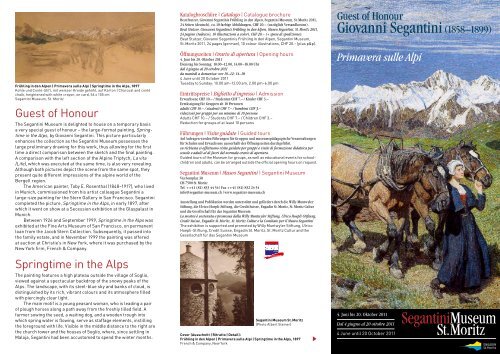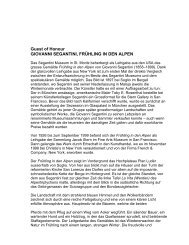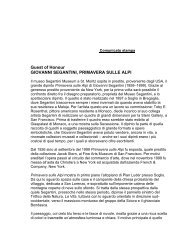Primavera sulle Alpi - Segantini Museum
Primavera sulle Alpi - Segantini Museum
Primavera sulle Alpi - Segantini Museum
Create successful ePaper yourself
Turn your PDF publications into a flip-book with our unique Google optimized e-Paper software.
Frühling in den Alpen | <strong>Primavera</strong> <strong>sulle</strong> <strong>Alpi</strong> | Springtime in the Alps, 1897<br />
Kohle und ContéStift, mit weisser Kreide gehöht, auf Karton | Charcoal and conté<br />
chalk, heightened with white crayon, on card, 56 x 105 cm<br />
<strong>Segantini</strong> <strong>Museum</strong>, St. Moritz<br />
Guest of Honour<br />
The <strong>Segantini</strong> <strong>Museum</strong> is delighted to house on a temporary basis<br />
a very special guest of honour – the largeformat painting, Springtime<br />
in the Alps, by Giovanni <strong>Segantini</strong>. This picture particularly<br />
enhances the collection as the <strong>Segantini</strong> <strong>Museum</strong> possesses the<br />
large preliminary drawing for this work, thus allowing for the first<br />
time a direct comparison between the sketch and the final painting.<br />
A comparison with the left section of the <strong>Alpi</strong>ne Triptych, La vita<br />
(Life), which was executed at the same time, is also very revealing.<br />
Although both pictures depict the scene from the same spot, they<br />
present quite different impressions of the alpine world of the<br />
Bergell region.<br />
The American painter, Toby E. Rosenthal (1848–1917), who lived<br />
in Munich, commissioned from his artist colleague <strong>Segantini</strong> a<br />
largesize painting for the Stern Gallery in San Francisco. <strong>Segantini</strong><br />
completed the picture, Springtime in the Alps, in early 1897, after<br />
which it went on show at a Secession exhibition at the Glaspalast in<br />
Munich.<br />
Between 1926 and September 1999, Springtime in the Alps was<br />
exhibited at the Fine Arts <strong>Museum</strong> of San Francisco, on permanent<br />
loan from the Jacob Stern Collection. Subsequently, it passed into<br />
the family estate, and in November 1999 the painting was offered<br />
at auction at Christie’s in New York, where it was purchased by the<br />
New York firm, French & Company.<br />
Springtime in the Alps<br />
The painting features a high plateau outside the village of Soglio,<br />
viewed against a spectacular backdrop of the snowy peaks of the<br />
Alps. The landscape, with its steelblue sky and banks of cloud, is<br />
distinguished by its rich, vibrant colours and its atmosphere filled<br />
with piercingly clear light.<br />
The main motif is a young peasant woman, who is leading a pair<br />
of plough horses along a path away from the freshly tilled field. A<br />
farmer sowing the seed, a waiting dog, and a wooden trough into<br />
which spring water is flowing, serve as staffage elements, instilling<br />
the foreground with life. Visible in the middle distance to the right are<br />
the church tower and the houses of Soglio, where, since settling in<br />
Maloja, <strong>Segantini</strong> had been accustomed to spend the winter months.<br />
Katalogbroschüre | Catalogo | Catalogue brochure<br />
Beat Stutzer, Giovanni <strong>Segantini</strong>s Frühling in den Alpen, <strong>Segantini</strong> <strong>Museum</strong>, St. Moritz 2011,<br />
24 Seiten (deutsch), ca. 10 farbige Abbildungen, CHF 20.– (zuzüglich Versandkosten).<br />
Beat Stutzer, Giovanni <strong>Segantini</strong>s Frühling in den Alpen, Museo <strong>Segantini</strong>, St. Moritz 2011,<br />
24 pagine (tedesco), 10 illustrazioni a colori, CHF 20.– (+ spese di spedizione).<br />
Beat Stutzer, Giovanni <strong>Segantini</strong>s Frühling in den Alpen, <strong>Segantini</strong> <strong>Museum</strong>,<br />
St. Moritz 2011, 24 pages (german), 10 colour illustrations, CHF 20.– (plus p&p).<br />
Öffnungszeiten | Orario di apertura | Opening hours<br />
4. Juni bis 20. Oktober 2011<br />
Dienstag bis Sonntag: 10.00–12.00, 14.00–18.00 Uhr<br />
dal 4 giugno al 20 ottobre 2011<br />
da martedì a domenica: ore 10–12; 14–18<br />
4 June until 20 October 2011<br />
Tuesday to Sunday: 10.00 am–12.00 am, 2.00 pm–6.00 pm<br />
Eintrittspreise | Biglietto d’ingresso | Admission<br />
Erwachsene CHF 10.– / Studenten CHF 7.– / Kinder CHF 3.–<br />
Ermässigung für Gruppen ab 10 Personen<br />
adulti CHF 10.– / studenti CHF 7.– / bambini CHF 3.–<br />
riduzioni per gruppi per un minimo di 10 persone<br />
Adults CHF 10.– / Students CHF 7.– / Children CHF 3.–<br />
Reduction for groups of at least 10 persons<br />
Führungen | Visite guidate | Guided tours<br />
Auf Anfragen werden Führungen für Gruppen und museumspädagogische Veranstaltungen<br />
für Schulen und Erwachsene ausserhalb der Öffnungszeiten durchgeführt.<br />
su richiesta si effettuano visite guidate per gruppi e visite di formazione didattica per<br />
scuole e adulti al di fuori del normale orario di apertura.<br />
Guided tours of the <strong>Museum</strong> for groups, as well as educational events for schoolchildren<br />
and adults, can be arranged outside the official opening hours on request.<br />
<strong>Segantini</strong> <strong>Museum</strong> | Museo <strong>Segantini</strong> | <strong>Segantini</strong> <strong>Museum</strong><br />
Via Somplaz 30<br />
CH-7500 St. Moritz<br />
Tel. ++41 (81) 833 44 54 | Fax ++41 (81) 832 24 54<br />
info@segantini-museum.ch | www.segantini-museum.ch<br />
Ausstellung und Publikation werden unterstützt und gefördert durch die Willy Muntwyler<br />
Stiftung, die Ulrico Hoepli-Stiftung, die Credit Suisse, Engadin St. Moritz, St. Moritz Cultur<br />
und die Gesellschaft für das <strong>Segantini</strong> <strong>Museum</strong><br />
La mostra è sostenuta e promossa dalla Willy Muntwyler Stiftung, Ulrico Hoepli-Stiftung,<br />
Credit Suisse, Engadin St. Moritz, St. Moritz Cultur e la Comitato per il Museo <strong>Segantini</strong><br />
The exhibition is supported and promoted by Willy Muntwyler Stiftung, Ulrico<br />
HoepliStiftung, Credit Suisse, Engadin St. Moritz, St. Moritz Cultur and the<br />
Gesellschaft für das <strong>Segantini</strong> <strong>Museum</strong><br />
<strong>Segantini</strong> <strong>Museum</strong> St. Moritz<br />
(Photo Albert Steiner)<br />
Cover (Ausschnitt | Ritratto | Detail):<br />
Frühling in den Alpen | <strong>Primavera</strong> <strong>sulle</strong> <strong>Alpi</strong> | Springtime in the Alps, 1897<br />
French & Company, New York<br />
Guest of Honour<br />
Giovanni <strong>Segantini</strong> (1858–1899)<br />
<strong>Primavera</strong> <strong>sulle</strong> <strong>Alpi</strong><br />
4. Juni bis 20. Oktober 2011<br />
Dal 4 giugno al 20 ottobre 2011<br />
4 June until 20 October 2011
Guest of Honour<br />
Das <strong>Segantini</strong> <strong>Museum</strong> freut sich, das grosse Gemälde Frühling in den<br />
Alpen von Giovanni <strong>Segantini</strong> als «guest of honour» eine Zeitlang beherbergen<br />
zu dürfen. Das macht Sinn, weil das <strong>Segantini</strong> <strong>Museum</strong> die grosse<br />
Entwurfszeichnung zu diesem Bild besitzt und zum ersten Mal der direkte<br />
Vergleich zwischen Skizze und Gemälde möglich ist. Auch der Vergleich<br />
mit dem linken Gemälde des Alpentriptychons La Vita (Werden), das zur<br />
gleichen Zeit entstanden ist, ist aufschlussreich. Beide Bilder zeigen vom<br />
gleichen Standort aus unterschiedliche Ansichten der Bergeller Bergwelt.<br />
Der in München ansässige, amerikanische Maler Toby E. Rosenthal<br />
(1848–1917) bestellte bei seinem Künstlerkollegen <strong>Segantini</strong> ein grossformatiges<br />
Gemälde für die Stern Gallery in San Francisco. <strong>Segantini</strong> stellte<br />
Frühling in den Alpen im Frühjahr 1897 fertig, um es an einer Ausstellung<br />
der Secession im Glaspalast in München zu zeigen.<br />
Von 1926 bis zum September 1999 befand sich der Frühling in den<br />
Alpen als Leihgabe der Sammlung Jacob Stern im Fine Arts <strong>Museum</strong> in San<br />
Francisco. Dann gelangte das Werk durch Erbschaft in den Kunsthandel,<br />
wo es im November 1999 bei Christie’s in New York verauktioniert und von<br />
der Firma French & Company, New York, erworben wurde.<br />
Frühling in den Alpen<br />
Das Bild zeigt im Vordergrund ein Hochplateau ausserhalb des Dorfes<br />
Soglio mit der Aussicht auf die imposante, schneebedeckte Kette der Berge<br />
im Hintergrund. Die Landschaft mit dem strahlend blauen Himmel und<br />
den Wolkenbändern zeichnet sich durch eine reiche Koloristik und eine<br />
von einem klaren Licht erfüllte Atmosphäre aus.<br />
Hauptmotiv ist die junge Bäuerin, welche die beiden angeschirrten<br />
Pferde auf einem Weg vom Acker wegführt. Ein säender Bauer, ein wartender<br />
Hund und ein Holztrog, in den das Quellwasser sprudelt, sind<br />
Staffageelemente, die den Vordergrund beleben. Rechts im Mittelgrund<br />
erkennt man den Kirchturm und die Häuser von Soglio, wo <strong>Segantini</strong> seit<br />
seiner Niederlassung in Maloja mit Vorliebe die Wintermonate verbrachte.<br />
Das Leben. Linkes Bild des Alpentriptychons. | La Vita. Il trittitico della natura<br />
parte sinistra | Life. Left section of the <strong>Alpi</strong>ne Triptych, 1896–1899<br />
Öl auf Leinwand | Olio su tela | Oil on canvas, 190 x 322 cm<br />
<strong>Segantini</strong> <strong>Museum</strong>, St. Moritz (Depositum der Gottfried KellerStiftung | Deposito<br />
di proprietà della Fondazione Gottfried Keller | On permanent loan from the<br />
Gottfried Keller Foundation)<br />
Frühling in den Alpen | <strong>Primavera</strong> <strong>sulle</strong> <strong>Alpi</strong> | Springtime in the Alps, 1897<br />
Öl auf Leinwand | Olio su tela | Oil on canvas | 116 x 227 cm | French & Company, New York<br />
Guest of Honour<br />
Il Museo <strong>Segantini</strong> è lieto di poter ospitare nelle sue sale, per un periodo<br />
limitato e come «guest of honour», il grande dipinto di Giovanni<br />
<strong>Segantini</strong> <strong>Primavera</strong> <strong>sulle</strong> <strong>Alpi</strong>. Non si tratta semplicemente di un caso:<br />
proprio al Museo <strong>Segantini</strong> appartiene infatti il grande disegno preparatorio<br />
di questo quadro, e per la prima volta è possibile un confronto<br />
diretto fra lo schizzo e il dipinto finale. Anche il paragone con il pannello<br />
sinistro del Trittico ispirato alle <strong>Alpi</strong>, realizzato proprio nello stesso<br />
periodo e che porta il titolo di La Vita, è alquanto significativo: entrambe<br />
le opere mostrano immagini diverse della vita nelle montagne della<br />
Bregaglia, osservate da un identico punto di vista.<br />
Toby E. Rosenthal (1848–1917), pittore americano residente a<br />
Monaco di Baviera, diede incarico al suo collega artista <strong>Segantini</strong> di<br />
realizzare un quadro di grandi dimensioni per la Stern Gallery, a San<br />
Francisco. <strong>Segantini</strong> completò il quadro <strong>Primavera</strong> <strong>sulle</strong> <strong>Alpi</strong> nella<br />
primavera del 1897, per poi esibirlo ad una mostra sulla Secessione nel<br />
Glaspalast, a Monaco di Baviera.<br />
Dal 1926 e sino al settembre del 1999, <strong>Primavera</strong> <strong>sulle</strong> <strong>Alpi</strong> fu conservato<br />
in prestito nella collezione Jacob Stern, al Fine Arts <strong>Museum</strong><br />
di San Francisco. A causa di un passaggio in eredità l’opera passò quindi<br />
nel circuito del mercato dell’arte. Nel novembre 1999 essa fu messa<br />
all’asta da Christie’s a New York, e acquistata dalla società French &<br />
Com pany di New York.<br />
<strong>Primavera</strong> <strong>sulle</strong> <strong>Alpi</strong><br />
Il quadro mostra in primo piano un altopiano ai margini del villaggio<br />
di Soglio. Sullo sfondo appare, in tutta la sua maestosità, la<br />
catena delle montagne, con le cime ancora ricoperte di neve. Il paesaggio,<br />
caratterizzato dalla luce intensa del cielo blu terso con i suoi<br />
fasci di nuvole, risalta grazie a una ricca scelta di colori, e trasmette<br />
un’atmosfera luminosa e chiara.<br />
Il motivo principale è quello della giovane contadina, che accompagna<br />
i due cavalli attaccati al carro sulla via dei campi. Un contadino<br />
nell’atto della semina, il cane in attesa e una mangiatoia di legno,<br />
nella quale gorgoglia una sorgente d’acqua, sono elementi puramente<br />
accessori, che animano la scena nel primo piano. A destra, nel centro,<br />
si riconoscono il campanile e<br />
le case di Soglio: <strong>Segantini</strong> amava<br />
trascorrere qui i mesi invernali,<br />
dopo aver stabilito la sua residenza<br />
a Maloja.<br />
Selbstbildnis | Autoritratto | Self-<br />
Portrait, 1895<br />
Kohle mit Goldstaub und Kreidespuren<br />
auf Leinwand | Carbone con<br />
polvere d’oro e trace di gessetto su<br />
tela | Charcoal with gold dust and<br />
traces of crayon on canvas,<br />
59 x 50 cm. <strong>Segantini</strong> <strong>Museum</strong>,<br />
St. Moritz




